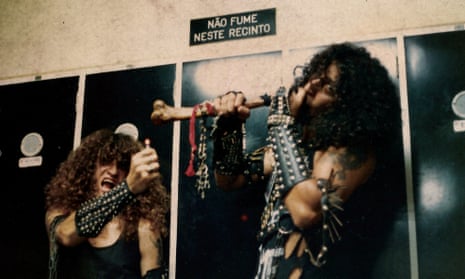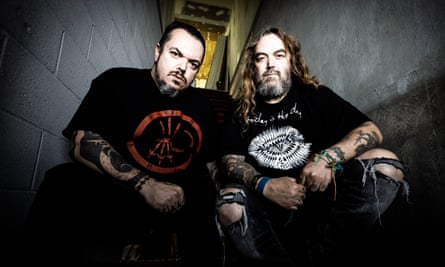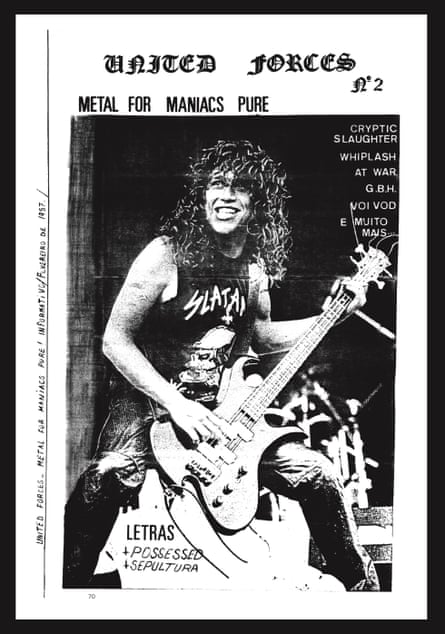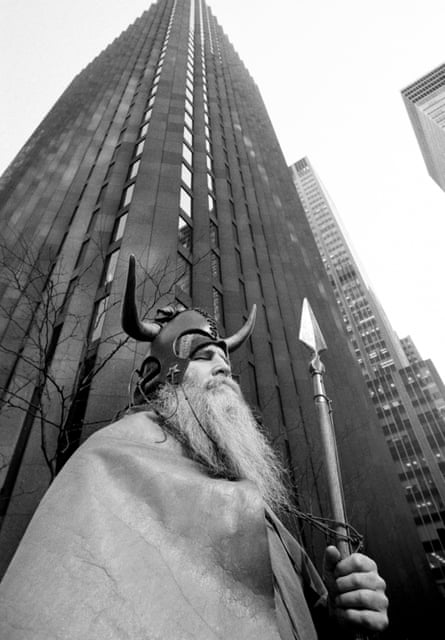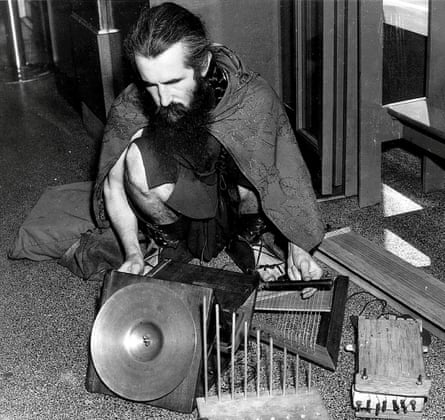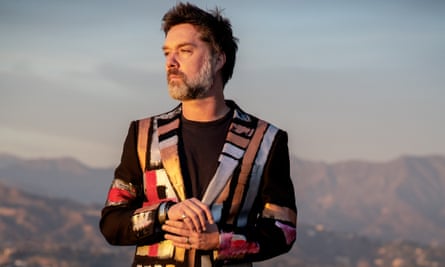UPDATED
A tentative agreement has been announced but what does it mean for the industry and the viewers?
Adrian Horton
THE GUARDIAN
Mon 25 Sep 2023
After nearly five months – 146 days, to be exact – the Hollywood writers’ strike appears to be nearing its end, as the Writers Guild of America (WGA) reached a provisional deal with the group representing the studios and streamers. If ratified by union membership, the deal would conclude one of the longest work stoppages in the union’s history; the current record was set in 1988, when the WGA struck for 154 days.
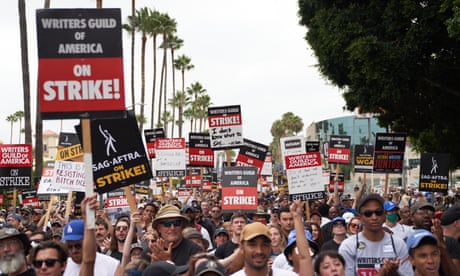
Hollywood writers’ strike: WGA reaches ‘tentative’ deal to end 146-day strike
The tentative agreement was announced on Sunday night after a marathon weekend of negotiations. “We can say, with great pride, that this deal is exceptional – with meaningful gains and protections for writers in every sector of the membership,” the WGA said in an email to strike captains on Sunday night.
While there is still much that is unclear – the nature of the deal, which still needs to be ironed out in contractual language and ratified by union leadership and its 11,500 members, has yet to be revealed – the picture of a post-strike Hollywood is coming into focus. Here is what we know so far:
What’s in the deal?
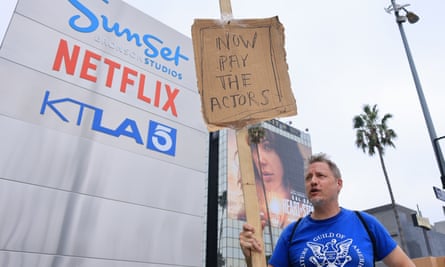
After nearly five months – 146 days, to be exact – the Hollywood writers’ strike appears to be nearing its end, as the Writers Guild of America (WGA) reached a provisional deal with the group representing the studios and streamers. If ratified by union membership, the deal would conclude one of the longest work stoppages in the union’s history; the current record was set in 1988, when the WGA struck for 154 days.

Hollywood writers’ strike: WGA reaches ‘tentative’ deal to end 146-day strike
The tentative agreement was announced on Sunday night after a marathon weekend of negotiations. “We can say, with great pride, that this deal is exceptional – with meaningful gains and protections for writers in every sector of the membership,” the WGA said in an email to strike captains on Sunday night.
While there is still much that is unclear – the nature of the deal, which still needs to be ironed out in contractual language and ratified by union leadership and its 11,500 members, has yet to be revealed – the picture of a post-strike Hollywood is coming into focus. Here is what we know so far:
What’s in the deal?

US screenwriter Travis Adam Wright walks with a homemade sign in front of Netflix.
Photograph: David Swanson/EPA
The provisional, three-year contract between the Alliance of Motion Picture and Television Producers (AMPTP) and the WGA will address the main three issues undergirding the strike: protections against the encroachment of artificial intelligence on writers’ work, residual payments for shows on streaming platforms and staffing minimums for writers’ rooms on TV shows.
Concerns around the future of AI emerged as arguably the leading issue and, for many, the most charged; Hollywood’s push into AI is already under way and the dual strike with the actors’ union offered one of the first and strongest labor opportunities to shape the path ahead for technology that will undoubtedly shape many employment sectors. The WGA was particularly concerned about the possibility that streamers and studios could use generative AI – the type of machine-learning systems capable of creating text, images and video, such as OpenAI’s ChatGPT – to cut costs by foregoing human writers for AI-produced scripts.
The details on the AI concessions are still scarce, but the Hollywood Reporter noted that negotiations over AI regulations were the final sticking point heading into the weekend. According to the New York Times, the AMPTP proposed this weekend to add a few paragraphs to the contract about AI and old scripts owned by studios. The two sides negotiated the language for several hours on the final night of talks.
The new agreement also reportedly includes a plan for residual compensations tied to streaming show performance that is not tied to health and pension funds. Residuals for shows that succeed on streaming platforms – such as this summer’s hit Suits, a 2010s legal drama that broke streaming records on Netflix – have lagged far behind those of shows on linear networks.
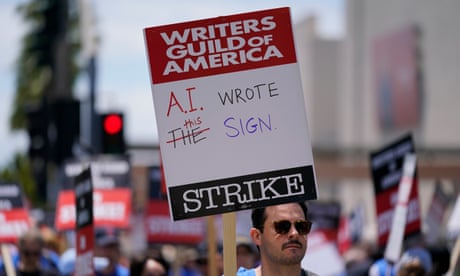
‘Embrace it or risk obsolescence’: how will AI jobs affect Hollywood?
Another sticking point was the WGA’s proposal for TV staffing minimums – six to 12 writers a show, depending on the number of episodes per season —– which the AMPTP had refused to consider and some within the guild privately opposed. In the final weeks of negotiations, the studios reportedly budged by offering showrunners flexibility to hire a certain number of writers based on the budget of the show. It remains unclear the precise compromise reached by the two sides on staffing minimums and the regulation of “mini-rooms”, seen by many as a way to avoid the cost of a full writers’ room.
The provisional, three-year contract between the Alliance of Motion Picture and Television Producers (AMPTP) and the WGA will address the main three issues undergirding the strike: protections against the encroachment of artificial intelligence on writers’ work, residual payments for shows on streaming platforms and staffing minimums for writers’ rooms on TV shows.
Concerns around the future of AI emerged as arguably the leading issue and, for many, the most charged; Hollywood’s push into AI is already under way and the dual strike with the actors’ union offered one of the first and strongest labor opportunities to shape the path ahead for technology that will undoubtedly shape many employment sectors. The WGA was particularly concerned about the possibility that streamers and studios could use generative AI – the type of machine-learning systems capable of creating text, images and video, such as OpenAI’s ChatGPT – to cut costs by foregoing human writers for AI-produced scripts.
The details on the AI concessions are still scarce, but the Hollywood Reporter noted that negotiations over AI regulations were the final sticking point heading into the weekend. According to the New York Times, the AMPTP proposed this weekend to add a few paragraphs to the contract about AI and old scripts owned by studios. The two sides negotiated the language for several hours on the final night of talks.
The new agreement also reportedly includes a plan for residual compensations tied to streaming show performance that is not tied to health and pension funds. Residuals for shows that succeed on streaming platforms – such as this summer’s hit Suits, a 2010s legal drama that broke streaming records on Netflix – have lagged far behind those of shows on linear networks.

‘Embrace it or risk obsolescence’: how will AI jobs affect Hollywood?
Another sticking point was the WGA’s proposal for TV staffing minimums – six to 12 writers a show, depending on the number of episodes per season —– which the AMPTP had refused to consider and some within the guild privately opposed. In the final weeks of negotiations, the studios reportedly budged by offering showrunners flexibility to hire a certain number of writers based on the budget of the show. It remains unclear the precise compromise reached by the two sides on staffing minimums and the regulation of “mini-rooms”, seen by many as a way to avoid the cost of a full writers’ room.
What’s next?
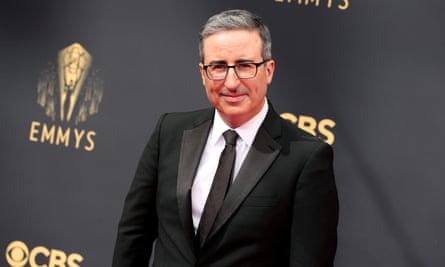
John Oliver’s HBO show could resume production within weeks.
Photograph: Rich Fury/Getty Images
It’s still possible that the strike could go on; the deal must now be ratified by the guild’s several leadership boards (including the union membership committee, WGA West’s board and WGA East’s council), which are set for a vote on Tuesday. After that, members will receive a summary of the agreement for a ratification vote.
In the meantime, the WGA has suspended picketing, though it reminded members that no one is to return to work until given the green light and the lawyerly contract is formalized. “What remains now is for our staff to make sure everything we have agreed to is codified in final contract language,” WGA reps said in the email to strike captains on Sunday night. “And though we are eager to share the details of what has been achieved with you, we cannot do that until the last ‘i’ is dotted.”
Writers could return to work quickly if union leadership approves the deal, as they can also vote to end the strike while the rank-and-file vote is still underway. “This would allow writers to return to work during the ratification vote, but would not affect the membership’s right to make a final determination on contract approval,” WGA leaders said.
It’s still possible that the strike could go on; the deal must now be ratified by the guild’s several leadership boards (including the union membership committee, WGA West’s board and WGA East’s council), which are set for a vote on Tuesday. After that, members will receive a summary of the agreement for a ratification vote.
In the meantime, the WGA has suspended picketing, though it reminded members that no one is to return to work until given the green light and the lawyerly contract is formalized. “What remains now is for our staff to make sure everything we have agreed to is codified in final contract language,” WGA reps said in the email to strike captains on Sunday night. “And though we are eager to share the details of what has been achieved with you, we cannot do that until the last ‘i’ is dotted.”
Writers could return to work quickly if union leadership approves the deal, as they can also vote to end the strike while the rank-and-file vote is still underway. “This would allow writers to return to work during the ratification vote, but would not affect the membership’s right to make a final determination on contract approval,” WGA leaders said.
However, most TV and film production will be unable to resume, as the actors’ strike is still under way and the joint strikes have already altered the production and release schedule for months to come. With performers still out, there will probably be long delays between script and screen and months before Hollywood work returns to pre-strike levels. Studios have pushed the release of major titles, such as Dune: Part Two and Luca Guadagnino’s Challengers, until 2024. Some TV shows, such as Amazon Prime’s A League of Their Own and The Peripheral, went from indefinitely delayed to cancelled, and the production on many others has been delayed.
Without such popular shows as Abbott Elementary and Young Sheldon, which shuttered their writers’ rooms for the strike in May, the major networks have already filled their fall TV schedules with reality programming and reruns. Fox developed a new game show called Snake Oil, while ABC expanded its Bachelor franchise with The Golden Bachelor, premiering this week. CBS is airing old episodes of Yellowstone in prime time and ABC began simulcasting ESPN broadcasts of Monday Night Football.
Some scripted network shows filmed before the strike, such as Quantum Leap and Magnum PI, will return with new seasons this fall; others, such as Grey’s Anatomy, Abbott Elementary and Law and Order, will not. With the WGA expected to ratify the deal, at least some of the 2023-2024 broadcast season could be saved, with production resuming for some shows as early as Thanksgiving.
Late-night and daytime television – the first casualties of the work stoppage in May – could get back on the air quickly. And Deadline reported on Monday that Saturday Night Live, which usually begins at the end of September, will get most of its season; the show is expected to return on 7 or 14 October, pending the WGA vote, with non-actor hosts and potentially without some cast members in solidarity with the actors.
Will this affect the actors’ strike?
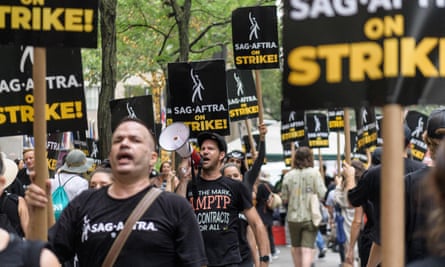
Sag-Aftra members and supporters walk the picket line in New York in July.
Photograph: Angela Weiss/AFP/Getty Images
Not directly – the Screen Actors Guild (Sag-Aftra), the union that represents more than 160,000 performers, has stressed that it will not be governed by other unions’ contract deals (as did the WGA, which was on strike after the directors’ guild reached a non-strike agreement with the AMPTP). The actors have been on a separate strike since 14 July, though many of its demands overlap with writers and many A-listers have picketed jointly with them.
Still, a deal with the WGA could provide a blueprint for resolving the actors’ strike, which has taken a mounting toll on performers and below-the-line staff. The tentative writers’ agreement addresses similar concerns to actors, namely strong guardrails against the encroachment of AI – actors are worried about the rights to their digital likenesses, for example – and streaming residuals.
While championing its own deal, the WGA has encouraged members to continue supporting actors on their picket lines when they resume on Tuesday.
Not directly – the Screen Actors Guild (Sag-Aftra), the union that represents more than 160,000 performers, has stressed that it will not be governed by other unions’ contract deals (as did the WGA, which was on strike after the directors’ guild reached a non-strike agreement with the AMPTP). The actors have been on a separate strike since 14 July, though many of its demands overlap with writers and many A-listers have picketed jointly with them.
Still, a deal with the WGA could provide a blueprint for resolving the actors’ strike, which has taken a mounting toll on performers and below-the-line staff. The tentative writers’ agreement addresses similar concerns to actors, namely strong guardrails against the encroachment of AI – actors are worried about the rights to their digital likenesses, for example – and streaming residuals.
While championing its own deal, the WGA has encouraged members to continue supporting actors on their picket lines when they resume on Tuesday.
‘We did it’: Hollywood writers react to ‘tentative agreement’ to end strike
Ellie Iorizzo
“Thank you thank you thank you to all of our strike captains who have held us down at every picket these last 146 days. Kept us hydrated, informed, sunblocked, safe from cars, and feeling encouraged. Love y’all!!”
Writer Caroline Renard of Disney’s Secrets Of Sulphur Springs, was also among those celebrating the agreement news.
She tweeted: “We got a deal. That was the hardest I’ve worked in forever. Captain signing off!”
Announcing the deal, days before the strike was set to become the longest in the union’s history, the WGA said: “What we have won in this contract – most particularly, everything we have gained since May 2 – is due to the willingness of this membership to exercise its power, to demonstrate its solidarity, to walk side-by-side, to endure the pain and uncertainty of the past 146 days.
“It is the leverage generated by your strike, in concert with the extraordinary support of our union siblings, that finally brought the companies back to the table to make a deal.”
As a result of the agreement, shows such as The Drew Barrymore Show could return to the air within days.
However, talks have not yet resumed between studios and striking actors who are part of Sag-Aftra (the Screen Actors Guild-American Federation of Television and Radio Artists).
The union, which represents around 160,000 members of the industry, has been on strike since July 14, causing a major stalling of multiple Hollywood productions.
It tweeted: “To our fellow union siblings who serve on the WGA Negotiating Committee, we extend our heartfelt congratulations on securing a tentative agreement with the AMPTP.
“We applaud your dedication and unwavering solidarity over the last five months and are proud to stand shoulder to shoulder with you as creative partners in the entertainment industry.”
Tentative WGA Deal Grants Members Who Are About To Lose Health Coverage An Extension Through End Of 2023
David Robb
Mon, September 25, 2023

WGA members who will lose their health coverage on October 1 will be granted extended coverage through the end of the year, per the guild’s tentative agreement. The extension also applies to writers who will exhaust their COBRA benefits eligibility. WGA members will soon be voting to ratify the new deal.
Union health plans have been taking a beating since the Writers Guild went on strike on May 2, followed by SAG-AFTRA on July 14, due to a lack of employer contributions. The Motion Picture Industry Pension & Health Plans (MPIPHP), which is covering IATSE’s West Coast locals, Teamsters Local 399 and several other industry unions, is reportedly down $150 million in employer contributions during the strikes.
More from Deadline
Dire Impact Of Strikes On Chicago IATSE Local’s Health Plan Could Be The Canary In The Coal Mine
It’s A Deal! WGA & AMPTP Reach Tentative Agreement To End Writers Strike; Picketing Suspended
WGA & AMPTP Deal's Impact On Film: Uptick In Feature Writers Job Market, But Actor Scheduling Conflicts Down The Road
Several other health plans, including those covering members of the DGA, SAG-AFTRA and IATSE, have made it easier to obtain health coverage during the strikes.
Last month, trustees of the SAG-AFTRA Health Plan unanimously agreed to a one-calendar-quarter extension of health coverage for certain qualified participants who would otherwise lose coverage on Oct. 1.
And trustees of the DGA Pension & Health Plans approved a free major medical plan last month for participants who lose coverage because of the strikes. The MPIPHP has also eased requirements that their members need to qualify for health coverage in order to help participants and dependents affected by the strikes.
Hollywood's writers strike is on the verge of ending. What happens next?
Will Gendron,AP
Mon, September 25, 2023
Two successful votes must happen before the strike is over
First, boards of the WGA's eastern and western branches must approve the deal. Then the 11,500 members themselves must vote for approval. Such votes are actually common with Hollywood unions, taking place every time a new three-year contract is negotiated, though they don't normally come at the end of a prolonged strike.
In the last writers strike, in 2008, board members voted two days after a deal was reached, and members voted two days after that. The agreement was approved overwhelmingly, with over 90% of writers voting yes.
That doesn't necessarily mean the vote is a sure thing. Some members are bound to be unsatisfied with the compromises their leaders reached on issues including compensation, the size of writing staffs, and the use of artificial intelligence in scriptwriting, especially after spending nearly five months out of work on picket lines.
When will writers return to work and shows return?
Once the contract is approved, work will resume more quickly for some writers than others. Late-night talk shows were the first to be affected when the strike began, and may be among the first to return to air now. NBC's "The Tonight Show Starring Jimmy Fallon," ABC's "Jimmy Kimmel Live" and CBS's "The Late Show With Stephen Colbert" could come back within days.
But while the show's joke writers will be free to return, many of their usual guests will not, with the ongoing actors strike bringing limits on such appearances. And the shows' returns amid that second strike could prove controversial, as it did for the planned-then-axed resumptions of daytime shows including "The Drew Barrymore Show" and "The Talk."
Film writers will also get back to work on their slower timeline, though those working on scripts or late revisions for already scheduled movies — including "Deadpool 3" and "Superman: Legacy" — will certainly be hustling to crack open their laptops and avoid further release-date delays.
How long will the actors strike last?
The studios that make up the AMPTP opted to finish a deal with writers — who went on strike two months earlier — before even beginning to deal with actors.
Leaders of SAG-AFTRA have said they have received no overtures from the AMPTP since their strike began on July 14. That is likely to change now, and another round of negotiations is likely to begin, though it remains to be seen how long that may take. It was three months into the writers strike before the AMPTP reached out to begin negotiations, and the initial talks sputtered after a just a few days. A month later, the studios came calling again, and this time the deal was done less than a week l
SAG-AFTRA members — on strike since July in the first combined walkout of both actors and writers since 1960 — said that they were heartened by developments with the WGA but staying in strike mode even as pressure on their personal finances hasn’t let up.
“I am OK,” actor, playwright and model Jason Duval Hunter told Deadline as he marched outside Paramount offices with about two dozen other picketers. “But I’m at the end of my savings, tapped out on my credit, and all of that good stuff. I’m in good spirits. I’m optimistic — good thing I have my hand in a lot of different avenues in this industry. I’ve been doing this since the ’80s.”
Hunter said that he was just in an off-Broadway play that paid “a little money” and that he walked the runway for Fashion Week in New York earlier this month.
Lila Donnolo — an actor, writer, podcaster and intimacy coach who is also doing copywriting to help pay bills — told Deadline after the Netflix/WBD rally, “I’m hopeful but pragmatic.”
Donnolo described artificial intelligence as a kind of wild card in contract talks once they resume between SAG-AFTRA and the AMPTP.
“How can we prevent future things that we don’t know about that would be awful for us as performers from happening?” Donnolo said, alluding to fears that generative AI could replicate and replace on-screen actors. “I think that takes a lot of more time and a lot more thought, which means more time for negotiation, which means dragging the strike on longer.
“It’s not simply wages,” Donnolo said. “There’s almost an existential fight that we’re fighting that is far greater.”
Hunter made a similar point, saying that AI and streaming technologies represent a “new era.”
“We needed to do this strike so that we can have an understanding: How do we make a living?” Hunter said.
At NBCUniversal, children’s television actor and writer Stephanie D’Abruzzo was not on strike because she works in programming that is covered under different contracts. But D’Abruzzo told Deadline that the WGA has set an example, and a tone, for the other contract negotiations — hers included — coming down the pipeline in film, television and video gaming.
“Their determination … has inspired SAG-AFTRA, a union that has had its share of division in the past, to truly come together and be united,” D’Abruzzo said.
“Obviously we don’t know what all of the details are with the WGA tentative contract, and with any situation you know that someone is going to be disappointed,” D’Abruzzo said. But she took it as a good sign that the WGA is calling the new deal “exceptional” in its official statement — in contrast with the more downbeat language that the union employed after the last writers’ strike in 2008.
This time around, she said, “The fact that the Writers Guild led the way, held strong, stayed united … is going to mean everything for the future.”
Robert Keniston, a Los Angeles-based actor originally from New York, marched outside Amazon offices with a dozen other picketers including his father.
“I’m out here on vacation so I’m taking some time to show solidarity,” Keniston told Deadline. He said that news of a potential end to the writers strike brought him “a healthy dose of optimism that we’ll get the contract we need.”
“I’ve been one of the lucky ones,” Keniston said. “I have a day job that’s not related so I’ve been able to make ends meet. But I definitely have friends who are struggling and have to rely on the SAG-AFTRA Foundation grant or the Entertainment [Community Fund] grant.”
Ashley Zukerman, who had a recurring role on all four seasons of HBO’s Succession, told Deadline after the Netflix/WBD rally, “We’ve just got to stay strong.”
“This has been very confusing and very cruel so it just doesn’t make any sense at all,” Zukerman said. “But we’re hopeful AMPTP comes clean.”

The Writers Guild of America has reached a tentative agreement with Hollywood studios after nearly 150 days of striking. The deal still has to be approved by union members.
Hollywood writers guild ends strike ahead of final contract vote
Actors ‘Thrilled’ About WGA Deal but Hope Studios Offer SAG-AFTRA What It ‘Needs and Deserves’ (Video)
Raquel 'Rocky' Harris
Tue, September 26, 2023 at 3:00 PM MDT·4 min read
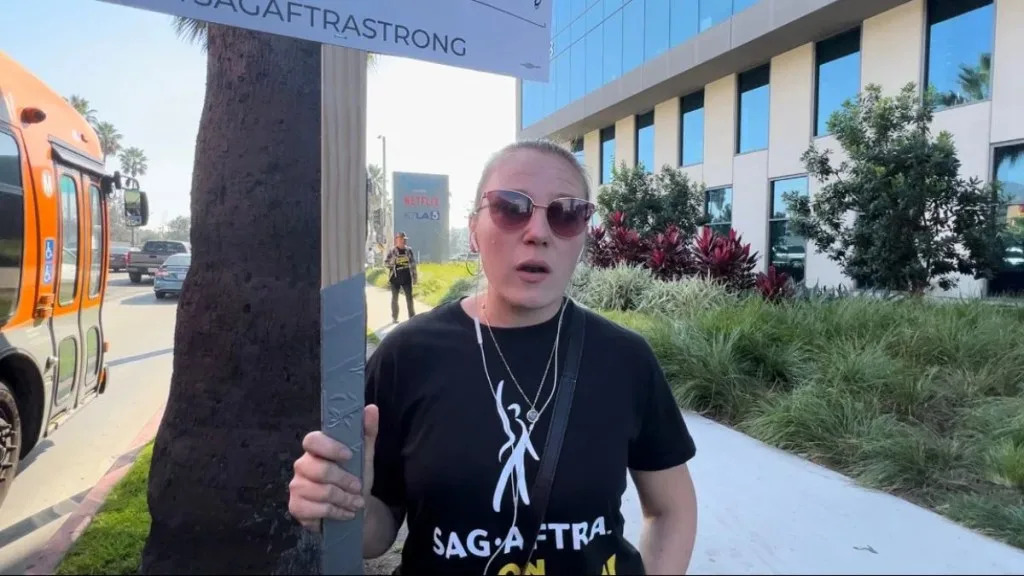
While on the picket lines, actors shared with TheWrap that they were excited about the Writers Guild of America’s deal and are hoping the studios give SAG-AFTRA members what they “need and deserve” in a contract.
“I was thrilled. So thrilled. The writers have been out on the line for almost triple what [actors have] been doing,” “The Walking Dead” actress Emma Bell told TheWrap on Tuesday. “The writers deserve everything that they feel they deserve. We would never have anything in this industry if we didn’t have [the writers], and it really made me hopeful for our deal.”
On Sunday, and after 146 days of striking, the Writers Guild reached a tentative deal with the AMPTP, sparking hope for possible talks with SAG-AFTRA. As TheWrap has reported, conversations are close but not imminent, and getting back to the table could take at least two weeks. And even after they agree to sit down again, the new round of negotiating could take longer than the five days the writers and AMPTP took.
The SAG-AFTRA strike will hit the 75-day mark Wednesday.
Nevertheless, actors and writers weighed in with their thoughts.
“I hope that the CEOs show up just like they did for the WGA so we can get this done,” Frances Fischer, actress and SAG-AFTRA negotiating committee member told TheWrap. “We have a huge package, much bigger than any other union because we have so many members and so many different categories of workers. I don’t prioritize because it all works together.”
As the WGA continues to sort out its contract with the AMPTP, the Actors Guild will have time to look over the writers’ deal, which in turn could help them steer their upcoming negotiation meeting with the studios, particularly on issues that overlap with other unions, including the use of artificial intelligence and minimum wage increases.
“Eleven percent, baby that’s where we’re at. Take a look at the economics for the last five to seven years. That’s where we’re at,” Kevin E. West, actor and SAG-AFTRA negotiating member, said referring to pay boosts for actors. “There’s certainly a mechanical difficulty of A.I. and an economical reality of financial share, but there’s also a day-to-day part of this union that goes all the way down to either something that has a lesser economic impasse on the AMPTP but still is equally as important to us. They are all important. “
West continued: “Quite frankly, it would just be easy if they’d just go ahead and sign the deal we left on the table. That’d make it really simple.”
While most were delighted at the progress made from the WGA deal, writer and producer Travis Adam Wright said he remains a bit skeptical.
“You know I wish I was more excited that I was. It’s kinda like when you’re in love with someone and they’ve broken your heart a couple of times, so you’re like, ‘Do they really love me? I’m not sure,” Wright said. “I was very lukewarm about it. We still haven’t read the details. Until we read the details of the deal, we don’t know what’s what.”
Ellie Iorizzo
EVENING STANDARD
Mon, September 25, 2023
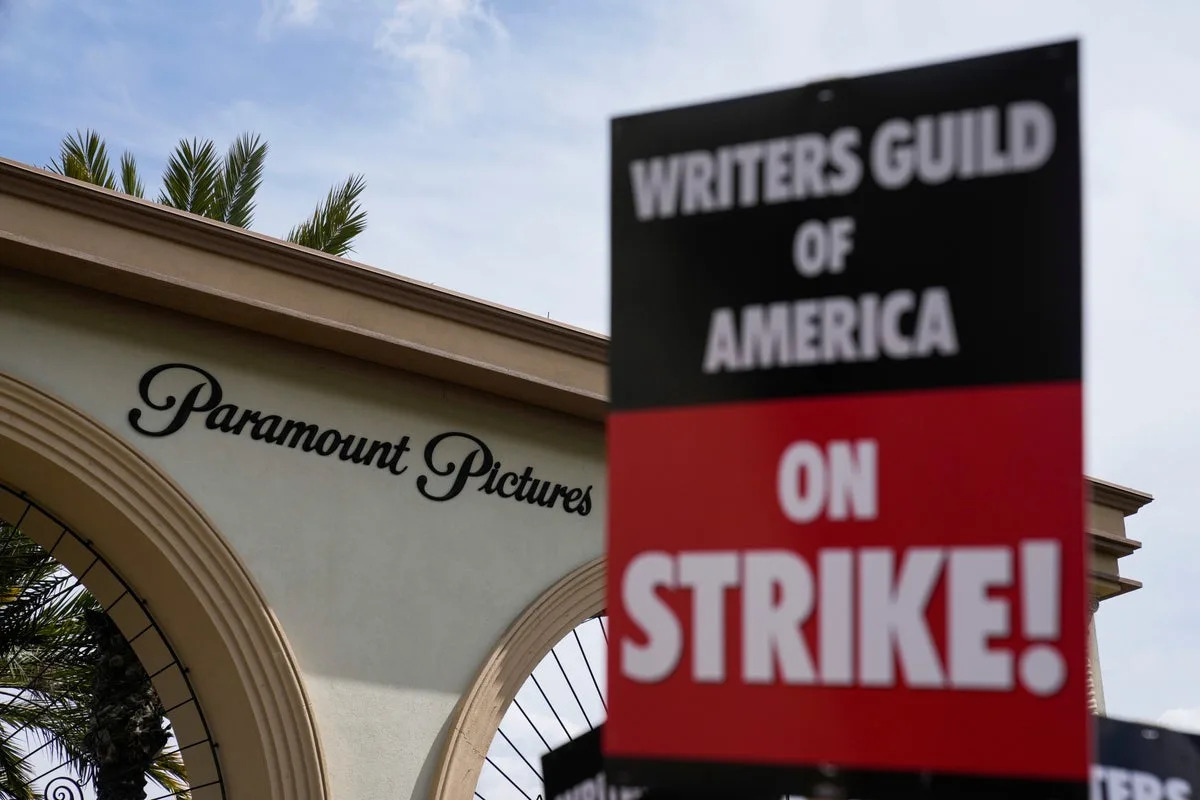
Writers in the US are praising a “tentative” deal that has been reached with Hollywood studio bosses which could mark the end of a strike that has lasted many months.
The Writers Guild of America (WGA) announced the deal with the Alliance of Motion Picture and Television Producers (AMPTP), the group which represents studios, streaming services and producers in negotiations, after 146 days on the picket line.
More than 11,000 WGA members have been on strike since May 2 over issues including pay and the threat of artificial intelligence (AI), however the terms of the new contract must be approved by the guild’s board and members before the strike officially ends.
On Monday, US comedian, writer and TV presenter Adam Conover, who wrote and starred in The G Word on Netflix, tweeted: “We did it. We have a tentative deal.
“Over the coming days, we’ll discuss and vote on it, together, as a democratic union. But today, I want to thank every single WGA member, and every fellow worker who stood with us in solidarity. You made this possible.”
US comedian, writer and chat show host Larry Wilmore reacted to the news on Twitter writing: “Finally!!!”
Alex Zaragoza, a writer on Amazon Freevee series Primo, said she reacted to the news by “crying, screaming, throwing up, (and) crying again”.
She tweeted: “This strike has been so hard. Necessary and invigorating, and really f****** hard. But we did it! We fought together.
Mon, September 25, 2023

Writers in the US are praising a “tentative” deal that has been reached with Hollywood studio bosses which could mark the end of a strike that has lasted many months.
The Writers Guild of America (WGA) announced the deal with the Alliance of Motion Picture and Television Producers (AMPTP), the group which represents studios, streaming services and producers in negotiations, after 146 days on the picket line.
More than 11,000 WGA members have been on strike since May 2 over issues including pay and the threat of artificial intelligence (AI), however the terms of the new contract must be approved by the guild’s board and members before the strike officially ends.
On Monday, US comedian, writer and TV presenter Adam Conover, who wrote and starred in The G Word on Netflix, tweeted: “We did it. We have a tentative deal.
“Over the coming days, we’ll discuss and vote on it, together, as a democratic union. But today, I want to thank every single WGA member, and every fellow worker who stood with us in solidarity. You made this possible.”
US comedian, writer and chat show host Larry Wilmore reacted to the news on Twitter writing: “Finally!!!”
Alex Zaragoza, a writer on Amazon Freevee series Primo, said she reacted to the news by “crying, screaming, throwing up, (and) crying again”.
She tweeted: “This strike has been so hard. Necessary and invigorating, and really f****** hard. But we did it! We fought together.
“Thank you thank you thank you to all of our strike captains who have held us down at every picket these last 146 days. Kept us hydrated, informed, sunblocked, safe from cars, and feeling encouraged. Love y’all!!”
Writer Caroline Renard of Disney’s Secrets Of Sulphur Springs, was also among those celebrating the agreement news.
She tweeted: “We got a deal. That was the hardest I’ve worked in forever. Captain signing off!”
Announcing the deal, days before the strike was set to become the longest in the union’s history, the WGA said: “What we have won in this contract – most particularly, everything we have gained since May 2 – is due to the willingness of this membership to exercise its power, to demonstrate its solidarity, to walk side-by-side, to endure the pain and uncertainty of the past 146 days.
“It is the leverage generated by your strike, in concert with the extraordinary support of our union siblings, that finally brought the companies back to the table to make a deal.”
As a result of the agreement, shows such as The Drew Barrymore Show could return to the air within days.
However, talks have not yet resumed between studios and striking actors who are part of Sag-Aftra (the Screen Actors Guild-American Federation of Television and Radio Artists).
The union, which represents around 160,000 members of the industry, has been on strike since July 14, causing a major stalling of multiple Hollywood productions.
It tweeted: “To our fellow union siblings who serve on the WGA Negotiating Committee, we extend our heartfelt congratulations on securing a tentative agreement with the AMPTP.
“We applaud your dedication and unwavering solidarity over the last five months and are proud to stand shoulder to shoulder with you as creative partners in the entertainment industry.”
Tentative WGA Deal Grants Members Who Are About To Lose Health Coverage An Extension Through End Of 2023
David Robb
Mon, September 25, 2023

WGA members who will lose their health coverage on October 1 will be granted extended coverage through the end of the year, per the guild’s tentative agreement. The extension also applies to writers who will exhaust their COBRA benefits eligibility. WGA members will soon be voting to ratify the new deal.
Union health plans have been taking a beating since the Writers Guild went on strike on May 2, followed by SAG-AFTRA on July 14, due to a lack of employer contributions. The Motion Picture Industry Pension & Health Plans (MPIPHP), which is covering IATSE’s West Coast locals, Teamsters Local 399 and several other industry unions, is reportedly down $150 million in employer contributions during the strikes.
More from Deadline
Dire Impact Of Strikes On Chicago IATSE Local’s Health Plan Could Be The Canary In The Coal Mine
It’s A Deal! WGA & AMPTP Reach Tentative Agreement To End Writers Strike; Picketing Suspended
WGA & AMPTP Deal's Impact On Film: Uptick In Feature Writers Job Market, But Actor Scheduling Conflicts Down The Road
Several other health plans, including those covering members of the DGA, SAG-AFTRA and IATSE, have made it easier to obtain health coverage during the strikes.
Last month, trustees of the SAG-AFTRA Health Plan unanimously agreed to a one-calendar-quarter extension of health coverage for certain qualified participants who would otherwise lose coverage on Oct. 1.
And trustees of the DGA Pension & Health Plans approved a free major medical plan last month for participants who lose coverage because of the strikes. The MPIPHP has also eased requirements that their members need to qualify for health coverage in order to help participants and dependents affected by the strikes.
Hollywood's writers strike is on the verge of ending. What happens next?
Will Gendron,AP
Mon, September 25, 2023

CHRIS DELMAS/Getty Images
In what lasted for almost five months, the writer's strike has seemingly reached an end.
On Sunday evening, the Writer's Guild of America came to a tentative agreement with Hollywood studios.
Here's how this impacts the entertainment landscape moving forward.
The Writers Guild of America has arrived at a "tentative agreement" with Hollywood studios, after striking for 146 days.
Following a marathon five-day bargaining session, both the Alliance of Motion Picture and Television Producers and the WGA released a joint statement Sunday evening, signalling a return to regularly scheduled programming is on the horizon.
Meanwhile, Hollywood's actors remain on strike — SAG-AFTRA, the actor's union, offered its congratulations to WGA — and there are still formalities needed to complete before the strike officially ends, with the WGA emailing its members that "no one is to return to work until specifically authorized to by the Guild."
"We are still on strike until then. But we are, as of today, suspending WGA picketing," it added.
So how will things proceed?
In what lasted for almost five months, the writer's strike has seemingly reached an end.
On Sunday evening, the Writer's Guild of America came to a tentative agreement with Hollywood studios.
Here's how this impacts the entertainment landscape moving forward.
The Writers Guild of America has arrived at a "tentative agreement" with Hollywood studios, after striking for 146 days.
Following a marathon five-day bargaining session, both the Alliance of Motion Picture and Television Producers and the WGA released a joint statement Sunday evening, signalling a return to regularly scheduled programming is on the horizon.
Meanwhile, Hollywood's actors remain on strike — SAG-AFTRA, the actor's union, offered its congratulations to WGA — and there are still formalities needed to complete before the strike officially ends, with the WGA emailing its members that "no one is to return to work until specifically authorized to by the Guild."
"We are still on strike until then. But we are, as of today, suspending WGA picketing," it added.
So how will things proceed?
Two successful votes must happen before the strike is over
First, boards of the WGA's eastern and western branches must approve the deal. Then the 11,500 members themselves must vote for approval. Such votes are actually common with Hollywood unions, taking place every time a new three-year contract is negotiated, though they don't normally come at the end of a prolonged strike.
In the last writers strike, in 2008, board members voted two days after a deal was reached, and members voted two days after that. The agreement was approved overwhelmingly, with over 90% of writers voting yes.
That doesn't necessarily mean the vote is a sure thing. Some members are bound to be unsatisfied with the compromises their leaders reached on issues including compensation, the size of writing staffs, and the use of artificial intelligence in scriptwriting, especially after spending nearly five months out of work on picket lines.
When will writers return to work and shows return?
Once the contract is approved, work will resume more quickly for some writers than others. Late-night talk shows were the first to be affected when the strike began, and may be among the first to return to air now. NBC's "The Tonight Show Starring Jimmy Fallon," ABC's "Jimmy Kimmel Live" and CBS's "The Late Show With Stephen Colbert" could come back within days.
But while the show's joke writers will be free to return, many of their usual guests will not, with the ongoing actors strike bringing limits on such appearances. And the shows' returns amid that second strike could prove controversial, as it did for the planned-then-axed resumptions of daytime shows including "The Drew Barrymore Show" and "The Talk."
Film writers will also get back to work on their slower timeline, though those working on scripts or late revisions for already scheduled movies — including "Deadpool 3" and "Superman: Legacy" — will certainly be hustling to crack open their laptops and avoid further release-date delays.
How long will the actors strike last?
The studios that make up the AMPTP opted to finish a deal with writers — who went on strike two months earlier — before even beginning to deal with actors.
Leaders of SAG-AFTRA have said they have received no overtures from the AMPTP since their strike began on July 14. That is likely to change now, and another round of negotiations is likely to begin, though it remains to be seen how long that may take. It was three months into the writers strike before the AMPTP reached out to begin negotiations, and the initial talks sputtered after a just a few days. A month later, the studios came calling again, and this time the deal was done less than a week l
Dispatches From The Picket Lines: Actors With A Smattering Of Rain & Writers Walk In NYC For First Time Since WGA Deal
Sean Piccoli
Tue, September 26, 2023

This is Day 76 of the SAG-AFTRA strike.
A fourth straight day of rain in New York City — the remnants of Tropical Storm Ophelia — greeted striking film and television workers who were back on picket lines this week for the first time since the announcement of a deal between the Writers Guild and the Alliance of Motion Picture and Television Producers.
More from Deadline
SAG-AFTRA Members Vote Overwhelmingly To Authorize Strike Against Video Game Industry
SAG-AFTRA Interim Agreements: Full List Of Movies And TV Series
Tentative WGA Deal Grants Members Who Are About To Lose Health Coverage An Extension Through End Of 2023
Although WGA pickets are suspended, a smattering of Guild members and their union representatives turned up on Tuesday to bolster rain-soaked SAG-AFTRA picket lines at the four locations in Manhattan where AMPTP studios are headquartered.
“SAG was there for WGA from Day 1, and they came out in such encouraging numbers when they really didn’t have to,” Eric Glover, a writer for the CW’s Tom Swift, told Deadline at the end of a soggy 2½-hour march outside Netflix and Warner Bros. Discovery offices. “I can’t technically be here in my WGA shirt, but I just wanted to be a warm body to provide support.”
Turnout overall was comparatively light on the day after Yom Kippur and a weekend of developments signaling a possible end to a writers walkout, now in its 22nd week. But SAG-AFTRA tents were up at all four sites — Netflix/WBD, NBCUniversal, Paramount and Amazon/HBO — with union representatives handing out ponchos, snacks and picket signs.
Marchers chanted, “Rain or shine/We walk the line/We won’t go home until the contract’s signed.”
Sean Piccoli
Tue, September 26, 2023

This is Day 76 of the SAG-AFTRA strike.
A fourth straight day of rain in New York City — the remnants of Tropical Storm Ophelia — greeted striking film and television workers who were back on picket lines this week for the first time since the announcement of a deal between the Writers Guild and the Alliance of Motion Picture and Television Producers.
More from Deadline
SAG-AFTRA Members Vote Overwhelmingly To Authorize Strike Against Video Game Industry
SAG-AFTRA Interim Agreements: Full List Of Movies And TV Series
Tentative WGA Deal Grants Members Who Are About To Lose Health Coverage An Extension Through End Of 2023
Although WGA pickets are suspended, a smattering of Guild members and their union representatives turned up on Tuesday to bolster rain-soaked SAG-AFTRA picket lines at the four locations in Manhattan where AMPTP studios are headquartered.
“SAG was there for WGA from Day 1, and they came out in such encouraging numbers when they really didn’t have to,” Eric Glover, a writer for the CW’s Tom Swift, told Deadline at the end of a soggy 2½-hour march outside Netflix and Warner Bros. Discovery offices. “I can’t technically be here in my WGA shirt, but I just wanted to be a warm body to provide support.”
Turnout overall was comparatively light on the day after Yom Kippur and a weekend of developments signaling a possible end to a writers walkout, now in its 22nd week. But SAG-AFTRA tents were up at all four sites — Netflix/WBD, NBCUniversal, Paramount and Amazon/HBO — with union representatives handing out ponchos, snacks and picket signs.
Marchers chanted, “Rain or shine/We walk the line/We won’t go home until the contract’s signed.”
SAG-AFTRA members — on strike since July in the first combined walkout of both actors and writers since 1960 — said that they were heartened by developments with the WGA but staying in strike mode even as pressure on their personal finances hasn’t let up.
“I am OK,” actor, playwright and model Jason Duval Hunter told Deadline as he marched outside Paramount offices with about two dozen other picketers. “But I’m at the end of my savings, tapped out on my credit, and all of that good stuff. I’m in good spirits. I’m optimistic — good thing I have my hand in a lot of different avenues in this industry. I’ve been doing this since the ’80s.”
Hunter said that he was just in an off-Broadway play that paid “a little money” and that he walked the runway for Fashion Week in New York earlier this month.
Lila Donnolo — an actor, writer, podcaster and intimacy coach who is also doing copywriting to help pay bills — told Deadline after the Netflix/WBD rally, “I’m hopeful but pragmatic.”
Donnolo described artificial intelligence as a kind of wild card in contract talks once they resume between SAG-AFTRA and the AMPTP.
“How can we prevent future things that we don’t know about that would be awful for us as performers from happening?” Donnolo said, alluding to fears that generative AI could replicate and replace on-screen actors. “I think that takes a lot of more time and a lot more thought, which means more time for negotiation, which means dragging the strike on longer.
“It’s not simply wages,” Donnolo said. “There’s almost an existential fight that we’re fighting that is far greater.”
Hunter made a similar point, saying that AI and streaming technologies represent a “new era.”
“We needed to do this strike so that we can have an understanding: How do we make a living?” Hunter said.
At NBCUniversal, children’s television actor and writer Stephanie D’Abruzzo was not on strike because she works in programming that is covered under different contracts. But D’Abruzzo told Deadline that the WGA has set an example, and a tone, for the other contract negotiations — hers included — coming down the pipeline in film, television and video gaming.
“Their determination … has inspired SAG-AFTRA, a union that has had its share of division in the past, to truly come together and be united,” D’Abruzzo said.
“Obviously we don’t know what all of the details are with the WGA tentative contract, and with any situation you know that someone is going to be disappointed,” D’Abruzzo said. But she took it as a good sign that the WGA is calling the new deal “exceptional” in its official statement — in contrast with the more downbeat language that the union employed after the last writers’ strike in 2008.
This time around, she said, “The fact that the Writers Guild led the way, held strong, stayed united … is going to mean everything for the future.”
Robert Keniston, a Los Angeles-based actor originally from New York, marched outside Amazon offices with a dozen other picketers including his father.
“I’m out here on vacation so I’m taking some time to show solidarity,” Keniston told Deadline. He said that news of a potential end to the writers strike brought him “a healthy dose of optimism that we’ll get the contract we need.”
“I’ve been one of the lucky ones,” Keniston said. “I have a day job that’s not related so I’ve been able to make ends meet. But I definitely have friends who are struggling and have to rely on the SAG-AFTRA Foundation grant or the Entertainment [Community Fund] grant.”
Ashley Zukerman, who had a recurring role on all four seasons of HBO’s Succession, told Deadline after the Netflix/WBD rally, “We’ve just got to stay strong.”
“This has been very confusing and very cruel so it just doesn’t make any sense at all,” Zukerman said. “But we’re hopeful AMPTP comes clean.”

The Writers Guild of America has reached a tentative agreement with Hollywood studios after nearly 150 days of striking. The deal still has to be approved by union members.
Hollywood writers guild ends strike ahead of final contract vote
Lisa Richwine and Dawn Chmielewski
Updated Tue, September 26, 2023
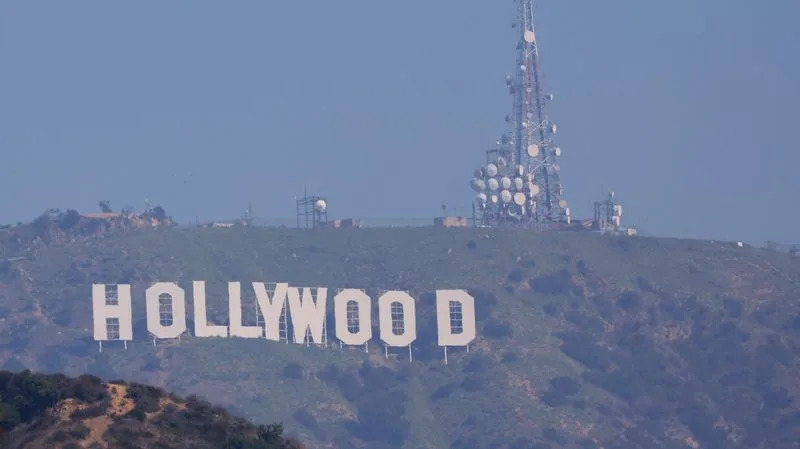
The iconic Hollywood sign is pictured the day after the Writers Guild of America (WGA) announced it reached a preliminary labor agreement with major studios in Los Angeles
LOS ANGELES (Reuters) -Hollywood's writers union said its members could return to work on Wednesday while they decide whether to approve a three-year deal that provides pay raises and some protections around use of artificial intelligence among other gains.
The Writers Guild of America (WGA) leadership voted unanimously to end the strike on Wednesday, the guild said in a statement. The 11,500 members have until Oct. 9 to cast their votes on the proposed contract.
The WGA said the estimated value of the deal was $233 million per year.
Film and television writers walked off the job in May after failing to reach a deal with major studios, including Netflix, Walt Disney and Warner Bros Discovery.
Writers appeared to have won concessions across the board, with raises over the three years of the contract, increased health and pension contributions, and AI safeguards.
Under the agreement, the studios agreed to meet at least twice a year with the guild to discuss plans to use AI in film development and production.
The studios are not expressly prohibited from using AI to generate content. Writers, however, have the right to sue if their work is used to train AI.
Writers can choose to use AI when drafting scripts, but a company cannot require the use of the software. The studios also must disclose to a writer if any materials were generated by AI.
In other areas, the guild said it won guarantees of minimum staffing in writers’ rooms, a key issue for many of its members. Staffing will be determined by the number of episodes per season. Minimum pay rates will climb by more than 12% over three years.
Also, residuals will rise for the use of TV shows and movies outside of the United States and a bonus will be awarded for the most popular shows on streaming.
"These are essential protections that the companies told us, to our faces, that they would NEVER give us," writer Adam Conover, a member of the guild's negotiating committee, posted on social media platform X.
"But because of our solidarity, because they literally cannot make a dollar without us, they bent, then broke, and gave us what we deserve. WE WON," Conover said.
Television writer David Slack said: "Our strike was necessary. Our strike was effective. Our strike is a victory."
The strike's end means daytime and late-night talk shows can return to the air. Bill Maher, host of HBO's "Real Time," said on social media that he would be back with fresh episodes starting Friday.
"My writers and Real Time are back!" Maher wrote.
Maher and Drew Barrymore had angered writers by saying this month that their talk shows would return before the strike ended.
The end of the WGA strike does not return Hollywood to normal. The SAG-AFTRA actors union walked off the job in July and remains on strike.
(Reporting by Lisa Richwine and Dawn Chmielewski; Editing by Jamie Freed, Leslie Adler and Gerry Doyle)
Updated Tue, September 26, 2023

The iconic Hollywood sign is pictured the day after the Writers Guild of America (WGA) announced it reached a preliminary labor agreement with major studios in Los Angeles
LOS ANGELES (Reuters) -Hollywood's writers union said its members could return to work on Wednesday while they decide whether to approve a three-year deal that provides pay raises and some protections around use of artificial intelligence among other gains.
The Writers Guild of America (WGA) leadership voted unanimously to end the strike on Wednesday, the guild said in a statement. The 11,500 members have until Oct. 9 to cast their votes on the proposed contract.
The WGA said the estimated value of the deal was $233 million per year.
Film and television writers walked off the job in May after failing to reach a deal with major studios, including Netflix, Walt Disney and Warner Bros Discovery.
Writers appeared to have won concessions across the board, with raises over the three years of the contract, increased health and pension contributions, and AI safeguards.
Under the agreement, the studios agreed to meet at least twice a year with the guild to discuss plans to use AI in film development and production.
The studios are not expressly prohibited from using AI to generate content. Writers, however, have the right to sue if their work is used to train AI.
Writers can choose to use AI when drafting scripts, but a company cannot require the use of the software. The studios also must disclose to a writer if any materials were generated by AI.
In other areas, the guild said it won guarantees of minimum staffing in writers’ rooms, a key issue for many of its members. Staffing will be determined by the number of episodes per season. Minimum pay rates will climb by more than 12% over three years.
Also, residuals will rise for the use of TV shows and movies outside of the United States and a bonus will be awarded for the most popular shows on streaming.
"These are essential protections that the companies told us, to our faces, that they would NEVER give us," writer Adam Conover, a member of the guild's negotiating committee, posted on social media platform X.
"But because of our solidarity, because they literally cannot make a dollar without us, they bent, then broke, and gave us what we deserve. WE WON," Conover said.
Television writer David Slack said: "Our strike was necessary. Our strike was effective. Our strike is a victory."
The strike's end means daytime and late-night talk shows can return to the air. Bill Maher, host of HBO's "Real Time," said on social media that he would be back with fresh episodes starting Friday.
"My writers and Real Time are back!" Maher wrote.
Maher and Drew Barrymore had angered writers by saying this month that their talk shows would return before the strike ended.
The end of the WGA strike does not return Hollywood to normal. The SAG-AFTRA actors union walked off the job in July and remains on strike.
(Reporting by Lisa Richwine and Dawn Chmielewski; Editing by Jamie Freed, Leslie Adler and Gerry Doyle)
Actors ‘Thrilled’ About WGA Deal but Hope Studios Offer SAG-AFTRA What It ‘Needs and Deserves’ (Video)
Raquel 'Rocky' Harris
Tue, September 26, 2023 at 3:00 PM MDT·4 min read

While on the picket lines, actors shared with TheWrap that they were excited about the Writers Guild of America’s deal and are hoping the studios give SAG-AFTRA members what they “need and deserve” in a contract.
“I was thrilled. So thrilled. The writers have been out on the line for almost triple what [actors have] been doing,” “The Walking Dead” actress Emma Bell told TheWrap on Tuesday. “The writers deserve everything that they feel they deserve. We would never have anything in this industry if we didn’t have [the writers], and it really made me hopeful for our deal.”
On Sunday, and after 146 days of striking, the Writers Guild reached a tentative deal with the AMPTP, sparking hope for possible talks with SAG-AFTRA. As TheWrap has reported, conversations are close but not imminent, and getting back to the table could take at least two weeks. And even after they agree to sit down again, the new round of negotiating could take longer than the five days the writers and AMPTP took.
The SAG-AFTRA strike will hit the 75-day mark Wednesday.
Nevertheless, actors and writers weighed in with their thoughts.
“I hope that the CEOs show up just like they did for the WGA so we can get this done,” Frances Fischer, actress and SAG-AFTRA negotiating committee member told TheWrap. “We have a huge package, much bigger than any other union because we have so many members and so many different categories of workers. I don’t prioritize because it all works together.”
As the WGA continues to sort out its contract with the AMPTP, the Actors Guild will have time to look over the writers’ deal, which in turn could help them steer their upcoming negotiation meeting with the studios, particularly on issues that overlap with other unions, including the use of artificial intelligence and minimum wage increases.
“Eleven percent, baby that’s where we’re at. Take a look at the economics for the last five to seven years. That’s where we’re at,” Kevin E. West, actor and SAG-AFTRA negotiating member, said referring to pay boosts for actors. “There’s certainly a mechanical difficulty of A.I. and an economical reality of financial share, but there’s also a day-to-day part of this union that goes all the way down to either something that has a lesser economic impasse on the AMPTP but still is equally as important to us. They are all important. “
West continued: “Quite frankly, it would just be easy if they’d just go ahead and sign the deal we left on the table. That’d make it really simple.”
While most were delighted at the progress made from the WGA deal, writer and producer Travis Adam Wright said he remains a bit skeptical.
“You know I wish I was more excited that I was. It’s kinda like when you’re in love with someone and they’ve broken your heart a couple of times, so you’re like, ‘Do they really love me? I’m not sure,” Wright said. “I was very lukewarm about it. We still haven’t read the details. Until we read the details of the deal, we don’t know what’s what.”
Wright continued, saying that he hopes that future dealmaking for the unions becomes more clear, and that unions push for more.
“I would love for us all to get back to work,” he said. “And three years from now, I’d love if we were striking for like 10% of profits or something real instead of 3%. You know, wow, we went from 3.6 to 3.8 of adjusted gross. As long as its adjusted gross, it might as well be fairy farts or something. Without transparency also in accounting, how do you know what they’re paying you? So I’m happy that we can all get back to work.”
He went on to say that without the united front of all the unions none of the progress made would have happened.
“We wouldn’t have gotten paid without SAG-AFTRA, period,” Wright added. “This is a collaborative medium. Without them we’re nothing. This industry can’t function without them, obviously. So they need to get paid and until they get paid, I’ll come out here every day.”
For all of TheWrap’s strike coverage, click here.
The Hollywood writers’ strike is over
Samantha Delouya, CNN
Tue, September 26, 2023

Mario Anzuoni/Reuters
The Hollywood writers strike is finally over after 148 days.
Leaders of the Writers Guild of America have unanimously voted to authorize its members to return to work following the tentative agreement reached Sunday between union negotiators and Hollywood’s studios and streaming services, effectively ending the months-long strike that has paralyzed the industry.
“The WGAW Board and WGAE Council also voted to lift the restraining order and end the strike as of 12:01 am PT/3:01 am ET on Wednesday, September 27th. This allows writers to return to work during the ratification process, but does not affect the membership’s right to make a final determination on contract approval,” the WGA wrote online.
The tentative agreement, reached earlier this week, marks a turning point for Hollywood’s film and TV studios after both the WGA and SAG-AFTRA, the union that represents actors, went on strike this summer to fight for higher pay and protections against artificial intelligence.
The contract, which will expire in May 2026, includes pay increases, better benefits, protections against the studios’ use of artificial intelligence, guarantees for streaming compensation, longer-duration employment terms and other perks.
Most writers’ minimum pay will increase 5% immediately, another 4% in May 2024 and then another 3.5% in May 2025. Health fund contributions will increase by a half percentage point to 12% of companies’ reportable earnings. And writers working on the same script will no longer need to split pension and health contributions.
Writers were particularly concerned about the growth of streaming, because they lose out on residuals that traditional television shows paid when they were re-run.
For big streaming projects, namely feature-length productions with a budget of at least $30 million, minimum writer compensation for a story and teleplay will increase 18% to $100,000. Residual pay minimums for big-budget streaming productions will increase by more than a quarter. And other residuals for video on-demand services will yield a 50% bonus to writers when the shows are watched by a fifth of domestic subscribers in the first three months of a project’s run. That means writers could take home more than $9,000 for a half-hour eposide, and more than $16,000 for a one-hour episode for big-budget productions on the top services.
Those services, such as Netflix, Disney+ and Max, also pledged to increase transparency about how many hours certain programs were streamed.
A summary of the agreement by the WGA included AI protections. “AI can’t write or rewrite literary material,” according to the summary, which also noted a requirement that AI-generated materials must be disclosed to writers.
The agreement also addressed streaming residuals and transparency for data around streaming. The rise of Netflix and other such services over the years have helped transform Hollywood, becoming a major issue in the writers’ and actors’ strikes.
Although union leadership has allowed union members to return to work, their contracts with the studios have not yet been officially ratified, meaning union members may still reject the terms of the deal, potentially prolonging a historic strike that has crippled many parts of the US entertainment industry.
A SAG-AFTRA spokesperson said in a statement regarding its own negotiations that the union is “reviewing the WGA’s tentative agreement and are committed to achieving a fair and just deal for our members.”
“We remain on strike in our TV/Theatrical/Streaming contract and will inform our members when there is negotiations news to share. We will not speculate regarding schedule or next steps,” the spokesperson said.
The union said “eligible voters will be able to vote from October 2nd through October 9th, and will receive ballot and ratification materials when the vote opens.”
The WGA officially began striking on May 2, making the strike one of the longest in its history. The current record was in 1988 when the WGA struck for 154 days.
The Hollywood strikes have been costly, with a nationwide economic impact of more than $5 billion, according to economists. The pain has been felt by more than just Hollywood insiders; restaurants and businesses that cater to the entertainment industry, like makeup and custodial work, have experienced a downturn, as well.
Bill Maher, who said he would return to air during the writers strike before backing off that pledge, announced Tuesday his show would officially come back Friday.
- CNN’s Eva Rothenberg contributed to this report
For more CNN news and newsletters create an account at CNN.com
“I would love for us all to get back to work,” he said. “And three years from now, I’d love if we were striking for like 10% of profits or something real instead of 3%. You know, wow, we went from 3.6 to 3.8 of adjusted gross. As long as its adjusted gross, it might as well be fairy farts or something. Without transparency also in accounting, how do you know what they’re paying you? So I’m happy that we can all get back to work.”
He went on to say that without the united front of all the unions none of the progress made would have happened.
“We wouldn’t have gotten paid without SAG-AFTRA, period,” Wright added. “This is a collaborative medium. Without them we’re nothing. This industry can’t function without them, obviously. So they need to get paid and until they get paid, I’ll come out here every day.”
For all of TheWrap’s strike coverage, click here.
The Hollywood writers’ strike is over
Samantha Delouya, CNN
Tue, September 26, 2023

Mario Anzuoni/Reuters
The Hollywood writers strike is finally over after 148 days.
Leaders of the Writers Guild of America have unanimously voted to authorize its members to return to work following the tentative agreement reached Sunday between union negotiators and Hollywood’s studios and streaming services, effectively ending the months-long strike that has paralyzed the industry.
“The WGAW Board and WGAE Council also voted to lift the restraining order and end the strike as of 12:01 am PT/3:01 am ET on Wednesday, September 27th. This allows writers to return to work during the ratification process, but does not affect the membership’s right to make a final determination on contract approval,” the WGA wrote online.
The tentative agreement, reached earlier this week, marks a turning point for Hollywood’s film and TV studios after both the WGA and SAG-AFTRA, the union that represents actors, went on strike this summer to fight for higher pay and protections against artificial intelligence.
The contract, which will expire in May 2026, includes pay increases, better benefits, protections against the studios’ use of artificial intelligence, guarantees for streaming compensation, longer-duration employment terms and other perks.
Most writers’ minimum pay will increase 5% immediately, another 4% in May 2024 and then another 3.5% in May 2025. Health fund contributions will increase by a half percentage point to 12% of companies’ reportable earnings. And writers working on the same script will no longer need to split pension and health contributions.
Writers were particularly concerned about the growth of streaming, because they lose out on residuals that traditional television shows paid when they were re-run.
For big streaming projects, namely feature-length productions with a budget of at least $30 million, minimum writer compensation for a story and teleplay will increase 18% to $100,000. Residual pay minimums for big-budget streaming productions will increase by more than a quarter. And other residuals for video on-demand services will yield a 50% bonus to writers when the shows are watched by a fifth of domestic subscribers in the first three months of a project’s run. That means writers could take home more than $9,000 for a half-hour eposide, and more than $16,000 for a one-hour episode for big-budget productions on the top services.
Those services, such as Netflix, Disney+ and Max, also pledged to increase transparency about how many hours certain programs were streamed.
A summary of the agreement by the WGA included AI protections. “AI can’t write or rewrite literary material,” according to the summary, which also noted a requirement that AI-generated materials must be disclosed to writers.
The agreement also addressed streaming residuals and transparency for data around streaming. The rise of Netflix and other such services over the years have helped transform Hollywood, becoming a major issue in the writers’ and actors’ strikes.
Although union leadership has allowed union members to return to work, their contracts with the studios have not yet been officially ratified, meaning union members may still reject the terms of the deal, potentially prolonging a historic strike that has crippled many parts of the US entertainment industry.
A SAG-AFTRA spokesperson said in a statement regarding its own negotiations that the union is “reviewing the WGA’s tentative agreement and are committed to achieving a fair and just deal for our members.”
“We remain on strike in our TV/Theatrical/Streaming contract and will inform our members when there is negotiations news to share. We will not speculate regarding schedule or next steps,” the spokesperson said.
The union said “eligible voters will be able to vote from October 2nd through October 9th, and will receive ballot and ratification materials when the vote opens.”
The WGA officially began striking on May 2, making the strike one of the longest in its history. The current record was in 1988 when the WGA struck for 154 days.
The Hollywood strikes have been costly, with a nationwide economic impact of more than $5 billion, according to economists. The pain has been felt by more than just Hollywood insiders; restaurants and businesses that cater to the entertainment industry, like makeup and custodial work, have experienced a downturn, as well.
Bill Maher, who said he would return to air during the writers strike before backing off that pledge, announced Tuesday his show would officially come back Friday.
- CNN’s Eva Rothenberg contributed to this report
For more CNN news and newsletters create an account at CNN.com










